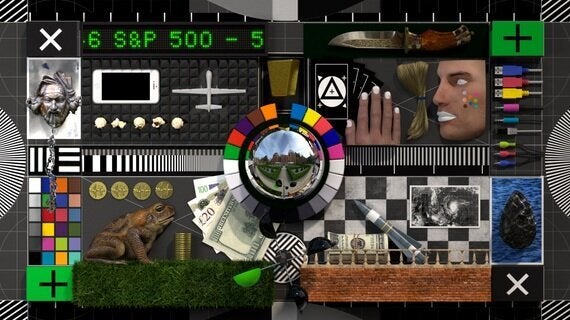
In 2014, the boss of Studio Ghibli, Hayao Miyazaki, surprised many when - as one of the most revered traditional animators in the world - he failed to condemn the CGI-heavy films of recent years. His assertion that "there's nothing inherently wrong or right about a method, whether it be pencil drawings or 3-D CG" must have disappointed many purists who see Miyazaki as a stalwart of traditional craft film-making. Similarly, crafty British ceramicist Grayson Perry in his BBC Reith Lecture championed the use of digital tools - CGI especially - and the possibilities it affords a new generation of artists.
Why is this so surprising? Well, for a long time, CGI has symbolised all that's wrong with the digital, an industrial light and magic show beloved by advertising and commercial film but despised by traditional artists who think it soulless, film technicians who resent it's perceived lack of craft, and film audiences who grow tired of the endless destruction porn in CGI blockbusters. As consumers we resent the onslaught of addictively perfect images in a world where our cars, houses and food - even our bodies - can't quite live up to the eerily glossy shots on buses, billboards or Instagram.
Maybe it's the pervasiveness of the CGI image that irks us. Or maybe it's because the digital has displaced so many analogue practices. In his 2013 book Software Takes Command, artist and digital theorist Lev Manovich argued that software has absorbed and reconfigured techniques from cinema, animation, photography, sculpture and painting, synthesising them into a powerful new software "metamedium". If that's true, no wonder so many traditional craftspeople resent CGI.
Or perhaps it's that CGI images are inherently slippery: they masquerade as photographic, yet underneath their glossy, seamless surface are wireframe shells, hollow and insubstantial. CGI doesn't age and acquire the patina of a Rembrandt and it has none of the traces of economical brushwork. You can't see the ingenious joinery as you might with a beautiful piece of furniture. There's no evidence of labour. It's all illusion, all spectacle, a little like table magic: if you can't see the labour - the joins - you assume it's a pretty cheap trick. Well, it's not.
That's the thread that I like to pull on as an artist working with software. I want to expose the trick, not simply to demonstrate that The Wizard of Oz is just a frail old man with a loudspeaker, but because CGI is the most complex and ideologically persuasive medium that has ever existed. It's exactly because we can't see the joins between a photograph and the digital mirage that it has such power. When something is both powerful and invisible, it's up to artists to expose the apparatus.
Unlike the code that software is made of, the effects of software are not binary - it doesn't just work or not work, and that's why many contemporary artists have moved past simplistic notion of "glitch" to an infinitely more interesting and sophisticated mode of investigation. Software is a spidery, ambiguous apparatus that reaches through society and culture at all levels to shape our behaviours, practices and beliefs. CGI itself is complex, expensive, time-consuming and difficult to master. The impenetrable CG image masks a complex reality of representational bias, human-computer collaboration, software politics, soft power tax incentives, 24/7 render farms, international trade deals, mineral extraction, gender imbalances, bankruptcy and wage fixing. It's far more than nerds clicking buttons, it's a multi-billion dollar industry whose influence continues to proliferate.
Contemporary digital artists tend to look past the tech-liberation hyperbole of software "enabling creativity" and try to understand how certain functions and features are prioritised and optimised over others. It's easier to blow up a CGI building with presets, for example, than it is to create a realistic tree. Or, as I discovered on a recent project working with digitally-generated crowds, CGI hordes are really good at marching in legions toward a grisly death, and not so good at representing anything that doesn't involve mass conflict. It was during the research phase of this crowd simulation project (an ENCAC residency at French theatre humainTrophumain) I came across an online library of motion capture data with categories like "Women's Movements" and "Gay". That's right, just "Gay". In 2016. You don't have to look very hard to discover that software is political. The scary thing is that software is as much a creative tool as it is a machine for reproducing ideology. Investigating the overlaps is where it gets interesting.
So to hear respected craft-based artists championing CGI is refreshing and unusual, especially in the midst of a Western obsession with nostalgia for simpler, more authentic times. For a long time, CGI has been a symbol of industrial depersonalisation, a heavyweight tool reserved for specialists: engineers, researchers, film studios and geeks. But as independent artists embrace technology and CGI starts to expand into more avant-garde and difficult-to-classify practices, we might start to see the naïve idea of software as an apolitical creative tool start to disappear. The risk is that if artists can't keep up with the 21st centuries greatest magic trick, we'll quickly lose something valuable in our relationship to images and truth.
So, CGI. They just do it with computers, don't they? Actually, it's not that simple.
Alan Warburton is an artist from London, UK. His latest work, "Soft Crash" uses CGI to investigate the mechanics of financial corruption, and it will be exhibited for free from the 25 June - 3 July at London's Southbank Centre as part of their Power of Power festival. http://www.southbankcentre.co.uk/whatson/alan-warburton-soft-crash-1001609